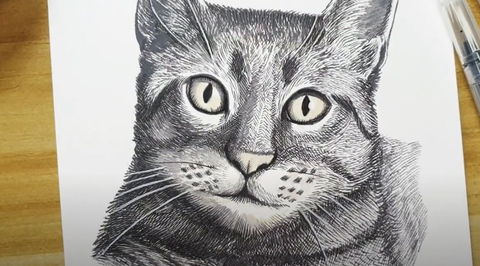Into the Creative Mind of Jackson Pollock: His Art, Style, and Story
Last Updated: July 29, 2024
“Every good painter paints what he is.” - Jackson Pollock
Very few are unaware of the name Jackson Pollock. Most people, whether they are art connoisseurs or not, have heard of the name, as it has become synonymous with million-dollar art and the elegance of abstract pieces.

But who is the man behind the distinctive painting technique and avant-garde approach to art? How did Jackson Pollock become a revolutionary figure in the world of abstract expressionism?
In this exploration, we delve into the creative mind of Jackson Pollock, peeking into the intricacies of his art, his amazingly unique style, and the compelling story behind the man who redefined the boundaries of contemporary art.
Pollock’s Early Years
Born on January 28, 1912, in Cody, Wyoming, Jackson Pollock grew up against the backdrop of the American West. His early exposure to Native American art and the expansive landscapes of his surroundings would later influence his artistic vision. Pollock's journey into art began at the Manual Arts High School in Los Angeles, where he discovered his passion for painting and drawing.

Jackson Pollock painting in his studio on Long Island, New York, 1950. Source: Hans Namuth
Pollock's formal art education continued at the Art Students League in New York City, where he studied under the tutelage of Thomas Hart Benton. Benton's regionalist style initially shaped Pollock's artistic inclinations, but it was during the 1930s that Pollock began to move away from representational art and embrace abstraction.
|
Did you know? Pollock was originally born Paul Jackson, but he decided to stop using his first name, Paul, around the time he moved to New York in 1930. |
The Drip Technique
One cannot discuss Jackson Pollock without delving into his revolutionary drip painting technique, which became synonymous with his name.
Pollock's innovative approach involved laying a canvas on the ground and, rather than using traditional brushes, dripping or pouring paint onto the canvas from above. This unorthodox method allowed him to create dynamic and intricate compositions, filled with energy and movement.

Autumn Rhythm, Number 30 (1950)
The creation of a Pollock painting was a performance in itself – a dance between artist and canvas. His physical engagement with the artwork was as crucial as the choice of colors and the rhythm of the drips.
Pollock's paintings, such as "Autumn Rhythm" and "Number 1A, 1948," are celebrated for their chaotic yet harmonious amalgamation of color and form.
The Emotional Expression
Pollock's art was not merely a display of technical prowess; it was a profound expression of emotion. He believed in the power of art to convey inner thoughts and feelings without the constraints of traditional representation. His drip paintings, with their seemingly random yet purposeful patterns, invite viewers to interpret and feel the art on a visceral level.

The act of dripping paint onto the canvas was a cathartic process for Pollock, allowing him to channel his innermost emotions directly onto the surface. Each drip, swirl, and splash of paint became a visual manifestation of his psyche, inviting viewers to explore the depths of their own emotions in response.
Create Expressive and Emotive Artwork with Abstraction!
The Impact of Surrealism and Jungian Psychology
Pollock's journey into abstraction was influenced by surrealism and the psychoanalytic theories of Carl Jung.
The Surrealists' emphasis on the subconscious and automatic writing resonated with Pollock, leading him to explore the depths of his own psyche in his art. His work also reflects Jung's concept of the collective unconscious, suggesting that Pollock tapped into a universal wellspring of symbols and archetypes.

Lavender Mist, Number 1 (1950)
Jackson Pollock’s Famous Artworks
Pollock created a body of work that continues to captivate art enthusiasts and critics alike. Here are some of his most famous artworks:
1. Autumn Rhythm, Number 30 (1950)
In this monumental work, Pollock employed his signature drip technique to create a sense of rhythm and movement. The painting's title suggests a connection to music, and indeed, the piece exudes a visual cadence that evokes the changing seasons.
2. Blue Poles, Number 11 (1952)
This large-scale painting features a series of vertical blue poles surrounded by a vibrant interplay of colors. The use of aluminum paint and the incorporation of wooden sticks into the composition add a three-dimensional quality to the work. "Blue Poles" is considered one of Pollock's masterpieces, showcasing his ability to balance chaos and control.
3. Lavender Mist, Number 1 (1950)
Often hailed as one of Pollock's finest achievements, "Lavender Mist" is a swirling tapestry of colors. The title, though seemingly descriptive, allows viewers to interpret the painting without imposing specific meaning, inviting a more personal and emotional connection.
4. Convergence (1952)

This powerful painting exemplifies Pollock's mastery of the drip technique. "Convergence" is a symphony of colors converging and colliding, creating a visually arresting and emotionally charged composition. The complexity of the intertwining lines and colors invites viewers to explore the depths of the painting.
5. No. 5, 1948 (1948)
With its dense web of interlacing lines and drips, "No. 5, 1948" is one of Pollock's most iconic works. The seemingly spontaneous yet carefully orchestrated composition captures the essence of his drip painting technique. In 2006, this painting became one of the most expensive artworks ever sold, fetching a record-breaking price at auction.
6. One: Number 31, 1950 (1950)
This monumental canvas showcases Pollock's bold and fearless approach to abstraction. Layers of dripped and poured paint create a dense and visually immersive experience. The sheer scale of the work amplifies its impact, drawing viewers into the intricate details of the composition.

The Struggles and Triumphs
Despite his artistic achievements, Jackson Pollock faced personal struggles, including alcoholism and marital issues with his wife, the artist Lee Krasner. These challenges, however, did not deter him from producing some of his most iconic works. The turbulent period of his life is encapsulated in his series of black and white paintings, which exude a raw intensity reflective of his internal struggles.
Tragically, Pollock's life was cut short in a car accident in 1956 at the age of 44. Yet, his impact on the art world endured, and his legacy continues to influence generations of artists who seek to break free from conventional artistic norms.
Learn How to Make Colorful, Expressive Art with These Artistry Classes!
The Life and Times of Jackson Pollock: A True Master of the Abstract Arts

Jackson Pollock's art is a testament to the transformative power of creative expression. His innovative approach to painting, characterized by the infamous drip technique, challenged the status quo and opened new avenues for artistic exploration.
Beyond the canvas, Pollock's work speaks to the human experience, inviting viewers to connect with their emotions on a profound level.
As we journey into the creative mind of Jackson Pollock, we find a complex and passionate artist who dared to push the boundaries of art, leaving an enduring legacy that transcends time. In his chaotic drips and swirling colors, we glimpse the inner workings of a mind that forever changed the landscape of modern art.
For more deep-dives into the life and times of famous artists, drop by The Creative Corner. Get inspiration and ideas for your next projects there!






